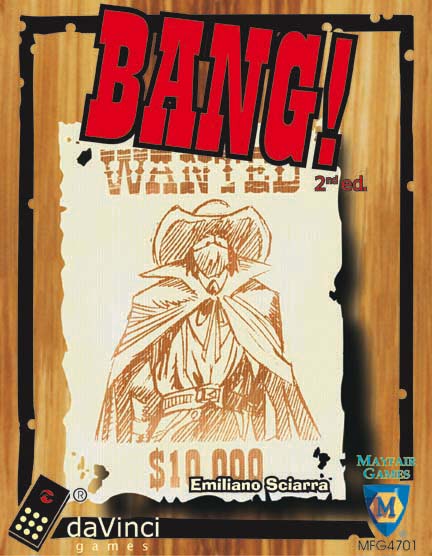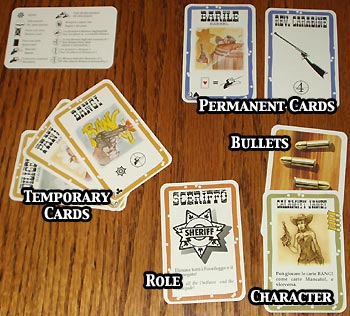
The game is basically a card driven variation of the game Mafia featuring basic role-playing elements like health, items, character roles and abilities. Each game features three basic factions: The Sheriff and his Vices, who want to purge the town of undesirables, the Outlaws aiming to take over the town by killing the lawmen, and the Renegade who must be the last man standing in order to win. Only the Sheriff's identity is public however, resulting in many cases of mistaken identity and hilarious alliances. In addition to the four different roles that determine players' agendas, each player draws a character card that has a special power, allowing them to draw more cards, or use cards in special ways. The rest of the deck consists of permanent equipment cards (guns and horses) which you lay down in front of you, and instant action cards (shooting, dodging, stealing cards) which you hold in your hand. The game's first expansion, Dodge City, is fairly essential as it introduces the Renegade role and semi-permanent single-use equipment cards. People tend to ignore the second two expansions which introduce condition cards that change the terms of play for one round.
 pic taken from RPG.net and found through google
pic taken from RPG.net and found through google
Here's a basic setup to give you an idea of what the game is like. Absent are the semi-permanant equipment cards of Dodge City and the Condition cards of High Noon and Fistful of Cards.
It sounds complicated, and it is, but it's much easier to explain, set-up and learn than something like Catan, or even Monopoly for that matter. Munchkin, another nerd favorite, tends to involve less guile and more negotiation, up until the end game when everybody starts screwing each other over. In Bang! you can run some truly impressive cons and screw people over without intending to, all in one match, sometimes with the same action. Word to the wise: flat out stating your role tends to make the game harder and less fun. By outing yourself as an outlaw, you provide other more cunning outlaws with a sacrificial lamb. All they have to do to look like good guys is shoot you dead. The exception to this rule is to claim to be the vice. No matter what you actually are, you want to look like the vice to the Sheriff. In fact, it's become something of an unspoken rule with my group. "I'm the vice!" "No, I'm the vice!" etc.
 pic taken from RPG.net and found through google
pic taken from RPG.net and found through googleHere's a basic setup to give you an idea of what the game is like. Absent are the semi-permanant equipment cards of Dodge City and the Condition cards of High Noon and Fistful of Cards.
 Pic taken from myfairgames.com ; as usual, found through google
Pic taken from myfairgames.com ; as usual, found through googleDespite a couple odd tweaks, The Bullet is definitely the edition you want. It has all the expansions, a couple of extra characters with ridiculous but fun powers, a sweet-looking bullet case, and a so-cheesy-it's-awesome Sheriff's Badge.
Some less alcoholic house rules that have proven fun are playing with two character powers at once (though some combinations are prohibited for balance reasons) and The Dual Schofield Rule, which states that a player may equip 2 Schofields and shoot at two different targets once in one turn. Normally, players can only shoot once in a turn, and they can only equip one gun. The rule sprang up after we watched the new 3:10 to Yuma and saw Charlie Prince waste about a hundred people with a pair of Schofields. It's the perfect house rule since it can only be implemented in rare circumstances, and it has a greater impact on style than substance. Other rule changes we use involve using the older versions of certain cards; as mentioned in the picture above, certain features were tweaked slightly in The Bullet edition of the game, including Ragtime being mistakenly misprinted as a "Shoot any player" card instead of a "Steal from any player" card, and a couple of character's lives being adjusted.
All in all, I cannot recommend Bang! highly enough since it's the sort of game almost everybody can enjoy, and at ~ $40 for The Bullet Edition, you'd be hard pressed to find a finer bargain. So git along, giddy up and have a gun fight or few. You won't be disappointed. In closing, some mood music.


